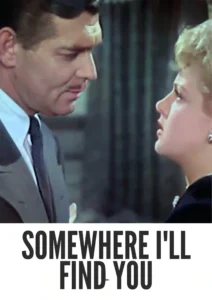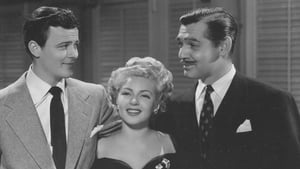Video Sources 0 Views
- Watch trailer
- Somewhere I'll Find You 1942 Colorized


Synopsis
Table of Contents
ToggleLove and War: Somewhere I’ll Find You (1942) in Vivid Color

Immerse yourself in the sweeping romance of Somewhere I’ll Find You, a captivating wartime drama from 1942, now beautifully colorized for a viewing experience that brings new life to this classic tale. Starring Clark Gable and Lana Turner, this film weaves a passionate love story against the backdrop of global conflict, delivering both heart-wrenching drama and thrilling adventure. Perfect for fans of classic romance and historical dramas, this HD download offers a chance to rediscover a timeless story of love and resilience. Also known as Red Light, don’t miss this extraordinary film.
Somewhere I’ll Find You Storyline: A Journalist’s Journey
Somewhere I’ll Find You follows the journey of war correspondent Jonny Davis (Clark Gable) as he travels the globe reporting on the escalating conflict of World War II. Driven by his commitment to truth and justice, Jonny finds himself in dangerous situations, witnessing the devastation and human cost of war firsthand.Amidst the chaos, Jonny’s personal life becomes intertwined with his professional one when he embarks on a search for his missing brother, Kirk (Robert Sterling), also a journalist. Along the way, he meets Paula Lane (Lana Turner), a passionate and courageous woman who captures his heart. Together, they navigate the challenges of war, facing danger and uncertainty as they strive to find Kirk and build a future together.
Movie Cast
The film boasts a stellar cast of actors who bring depth and emotion to this sweeping wartime romance:
- Clark Gable as Jonny Davis
- Lana Turner as Paula Lane
- Robert Sterling as Kirk Davis
- Patricia Dane as Crystal McClean
- Lee Patrick as Eve
Movie Genre
Somewhere I’ll Find You falls into the genre of romantic wartime drama, blending elements of romance, adventure, and historical drama to create a compelling and emotional narrative. Its sweeping scope and heartfelt performances make it a timeless classic.
Historical Context: Hollywood and World War II
Released in 1942, Somewhere I’ll Find You reflects Hollywood’s growing involvement in World War II, with studios producing films that aimed to inspire patriotism and support the war effort. The film captures the spirit of the time, showcasing the sacrifices and challenges faced by those on the front lines and at home. While Somewhere I’ll Find You may not be considered a definitive war film, it offers a valuable glimpse into the social and cultural landscape of the era.
Colorization Details
This colorized version of Somewhere I’ll Find You has been meticulously restored using modern digital techniques, enhancing the visual appeal while preserving the film’s original atmosphere. The colorization process involved carefully analyzing the grayscale tones of the original black and white footage and assigning appropriate colors to each scene. This painstaking process brings new life to the characters and settings, making the story even more engaging for modern audiences. While some may debate the merits of colorizing classic films, it introduces these films to a broader audience, ensuring their legacy for future generations.
Technical Details
- Director: Wesley Ruggles
- Screenplay: Marguerite Roberts
- Story: Charles Hoffman
- Cinematography: Harold Rosson
- Edited by: George Boemler
- Production Company: Metro-Goldwyn-Mayer (MGM)
- Distributed by: Metro-Goldwyn-Mayer (MGM)
- Runtime: 105 minutes
Technical Specifications
- Download Format: MP4
- Resolution: HD (1080p)
- Compatibility: Compatible with most devices, including smartphones, tablets, computers, and smart TVs.
Reviews and Critical Reception
Somewhere I’ll Find You (1942) is a classic Hollywood romance that showcases the star power of Clark Gable and Lana Turner. Its blend of romance, adventure, and wartime drama has resonated with audiences for generations, making it a beloved film in the genre. As a testament to the enduring appeal of classic Hollywood, Somewhere I’ll Find You remains a captivating and entertaining cinematic experience.
FAQs
- Q: What is Somewhere I’ll Find You about?
- A: Somewhere I’ll Find You is a romantic wartime drama about a war correspondent who searches for his missing brother and finds love along the way.
- Q: Who are the main stars of Somewhere I’ll Find You (1942)?
- A: The film stars Clark Gable and Lana Turner in leading roles.
- Q: Is this version of Somewhere I’ll Find You colorized?
- A: Yes, this version has been professionally colorized to enhance the viewing experience.
- Q: What makes Somewhere I’ll Find You a classic film?
- A: Somewhere I’ll Find You combines romance, adventure, and wartime drama, with memorable performances from its stars, making it a beloved film in the genre.
- Q: What is the download format?
- A: The download format is MP4, which is compatible with most devices.
- Q: What resolution is the download?
- A: The resolution is HD (1080p), providing a high-quality viewing experience.
Download Now in HD!
Watch Somewhere I’ll Find You Today!











